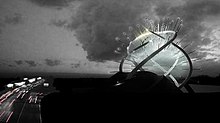Star of Caledonia

Artist's impression of the Star of Caledonia at night
|
|
| Coordinates | 54°59′54″N 3°03′17″W / 54.998383°N 3.054854°W |
|---|---|
| Location | Gretna, Dumfries and Galloway, Scotland |
| Designer | Cecil Balmond, Charles Jencks and Andy Goldsworthy |
| Type | Star |
| Material | steel frame lit by LEDs |
The Star of Caledonia, also called the Gretna Landmark, is a planned sculpture designed by Cecil Balmond, Charles Jencks and Andy Goldsworthy. It is to be located near Gretna, Dumfries and Galloway, Scotland, close to the England-Scotland border. The sculpture was approved on 27 February 2013. The project is being promoted by the Gretna Landmark Trust.
The project was first instigated by local businesses and landowner Alisdair Houston. The sculpture is hoped to bring social and economic benefits to the area. Other interested parties included both Gretna and Gretna Green and public art manager Jan Hogarth. The sculpture is hoped to bring visitors to the area to boost tourism.
About 84% of all visitors to Scotland by road pass near Gretna. For the past seven years, meetings have been held with Scottish academics, cultural thinkers and the local community in a series of seminars and workshops run by the Gretna Landmark Project which resulted in the appointment of international architect Charles Jencks as the Trust's Creative Director. In 2011 a competition was launched by the Gretna Landmark Trust called "The Great Unknown" as a way to get ideas for a new local iconic landmark. Three shortlisted artists and designers collaborated with Jencks on proposals for the landmark. In July 2011 it was announced that Cecil Balmond had won the competition with the Star of Caledonia design. Planning permission was first proposed in 2012. A debate on the proposal was later held in the Scottish National Gallery in Edinburgh in October 2011 by the two artists.
It was also hoped that the sculpture would be built in early 2014, in time for both the 2014 Commonwealth Games and 2014 Homecoming Scotland, and only taking a year to build. However, the projected date then slipped to 2015, which had been designated the UNESCO International Year of Light. This date has slipped past as well.
...
Wikipedia
